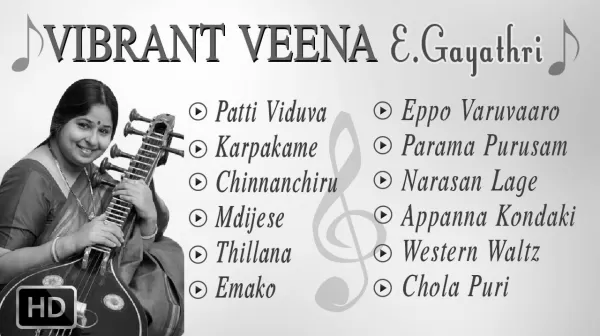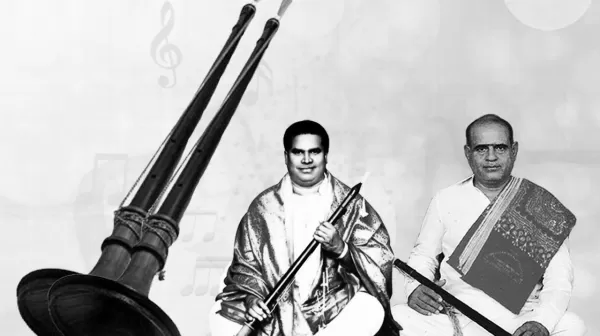Geethanjali - Indian Classical Music
Nadhaswaram ❤️ Classical Instrumental ❤️ Abheri ❤️ Jayashankar & Valayapatti Subramaniam
Abheri (pronounced ābhēri) is a raga in Carnatic music (musical scale of South Indian classical music). It is a Janya raga (derived scale), whose Melakarta raga (parent, also known as janaka) is Kharaharapriya, 22nd in the 72 Melakarta raga system. Bhimplasi (or Bheemplas) of Hindustani music sounds pretty close to Abheri. Classical music is art music produced or rooted in the traditions of Western music (both liturgical and secular). It encompasses a broad span of time from roughly the 11th century to the present day.
Maha Ganapati ❤️ Veena ❤️ Classical Instrumental ❤️ E. Gayathri
Mahaganapati, also spelled as Maha Ganapati is an aspect of the Hindu god Ganesha. He is the representation of Ganesha as the Supreme Being and is the most important deity of the Ganesha-centric Ganapatya sect. He is one of the most popular of the thirty-two forms of Ganesha. In earliest Veena was an instrument of the harp type whose type survives in the Burmese harp, whereas in the last centuries and nowadays, the word has tended to be applied to instruments of the lute type or even, recently, to certain kinds of guitars developed in India.
Rama Rama ❤️ Classical Instrumental ❤️ Veena ❤️ E.Gayathri
Classical music is art music produced or rooted in the traditions of Western music (both liturgical and secular). It encompasses a broad span of time from roughly the 11th century to the present day. In earliest Veena was an instrument of the harp type whose type survives in the Burmese harp, whereas in the last centuries and nowadays, the world has tended to be applied to instruments of the lute type or even, recently, to certain kinds of guitars developed in India.
Veena ❤️ Classical Instrumental ❤️ Nee Irangayenil ❤️ E.Gayathri
Classical music is art music produced or rooted in the traditions of Western music (both liturgical and secular). It encompasses a broad span of time from roughly the 11th century to the present day.. The earliest Veena was an instrument of the harp type whose type survives in the Burmese harp, whereas in the last centuries and nowadays, the word has tended to be applied to instruments of the lute type or even, recently, to certain kinds of guitars developed in India.
Classical Instrumental ❤️ Veena ❤️ Mokshamu Galada ❤️ E.Gayathri
The earliest Veena was an instrument of the harp type whose type survives in the Burmese harp, whereas in the last centuries and nowadays, the word has tended to be applied to instruments of the lute type or even, recently, to certain kinds of guitars developed in India. The more popular sitar is believed to have been derived from a type of Veena which was modified by a Mughal court musician to conform with the tastes of his Persian patrons. A person who plays a Veena is called a vainika.
Veena ❤️ Classical Instrumental ❤️ Theruvadheppo ❤️ E.Gayathri
In earliest Veena was an instrument of the harp type whose type survives in the Burmese harp, whereas in the last centuries and nowadays, the word has tended to be applied to instruments of the lute type or even, recently, to certain kinds of guitars developed in India. The more popular sitar is believed to have been derived from a type of Veena which was modified by a Mughal court musician to conform with the tastes of his Persian patrons. A person who plays a Veena is called a vainika.
Veena ❤️ Classical Instrumental ❤️ Vadavarayai Mathakki ❤️ E.Gayathri
Classical music is art music produced or rooted in the traditions of Western music (both liturgical and secular). It encompasses a broad span of time from roughly the 11th century to the present day.. The Veena is a plucked stringed instrument originating in ancient India, used mainly in Carnatic classical music and Hindustani classical music. The name is used for several instruments belonging to different families, mainly the Rudra Veena (a zither) and the Saraswati veena (a necked bowl lute) but also to other types of plucked string instruments (Mohan Veena, Ancient Veena etc).
Veena ❤️ Classical Instrumental ❤️ Adathu Asangathu ❤️ E.Gayathri
The Veena is a plucked stringed instrument originating in ancient India, used mainly in Carnatic classical music and Hindustani classical music.
Veena ❤️ Classical Instrumental ❤️ Senthamizh Nadenum Pothinile ❤️ E.Gayathri
Veena is a plucked stringed instrument originating in ancient India, used mainly in Carnatic classical music and Hindustani classical music. The name is used for several instruments belonging to different families, mainly the Rudra Veena (a zither) and the Saraswati veena (a necked bowl lute) but also to other types of plucked string instruments (Mohan Veena, Ancient Veena etc). Echampati Gayathri (née Gayathri Vasantha Shoba), popularly known as "Veena Gayathri" is a veena exponent of the traditional Carnatic music.
Veena ❤️ Thillana ❤️ Classical Instrumental ❤️ E.Gayathri
A Thillana or thillana is a rhythmic piece in Carnatic music that is generally performed at the end of a concert and widely used in dance performances.A Tillana uses tala-like phrases in the pallavi and anupallavi, and lyrics in the charanam. Some have theorized that it is based on the Hindustani tarana. Echampati Gayathri (née Gayathri Vasantha Shoba), popularly known as "Veena Gayathri" is a veena exponent of the traditional Carnatic music.










